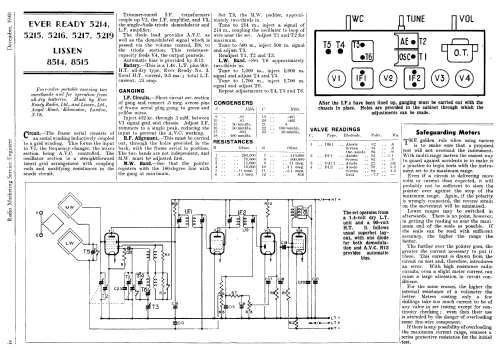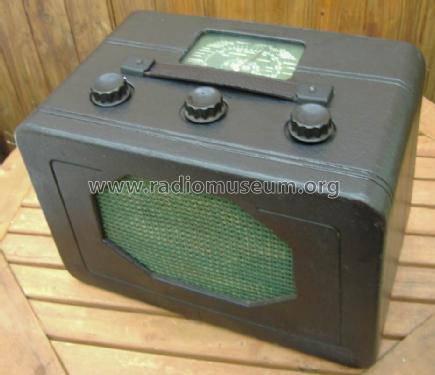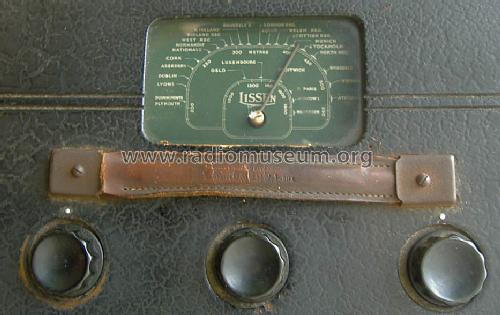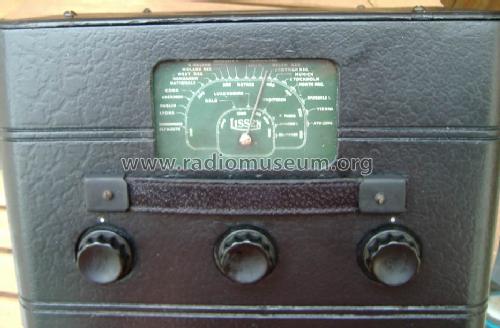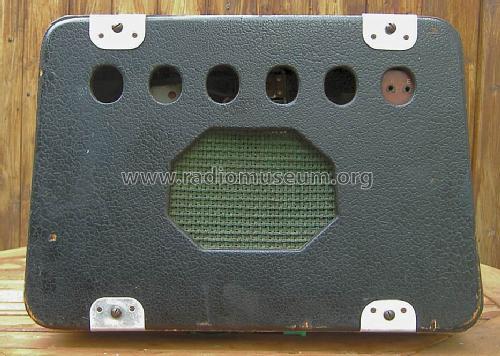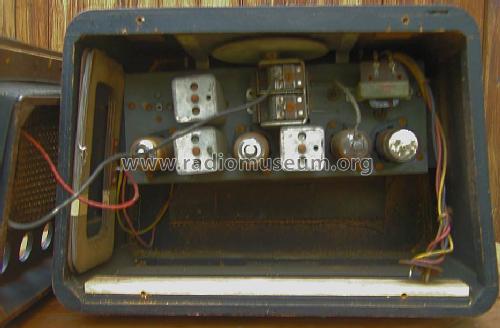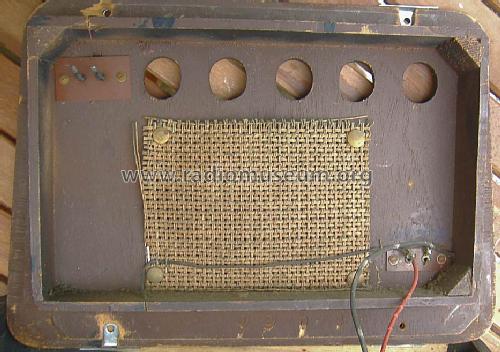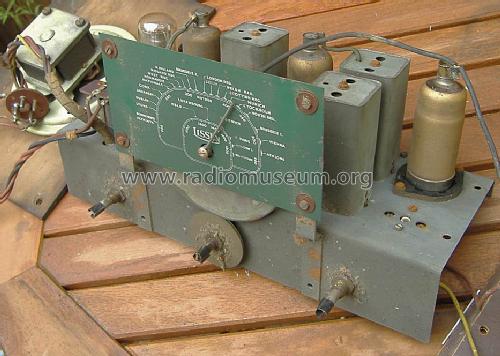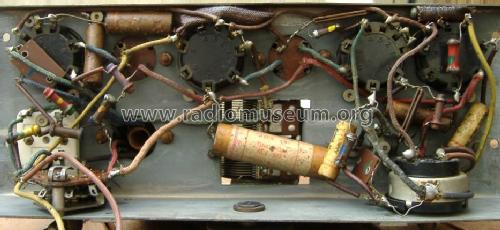All Dry Battery Portable 8515
Lissen Ltd.; London and Richmond, Surrey
- Country
- Great Britain (UK)
- Manufacturer / Brand
- Lissen Ltd.; London and Richmond, Surrey
- Year
- 1939
- Category
- Broadcast Receiver - or past WW2 Tuner
- Radiomuseum.org ID
- 222211
Click on the schematic thumbnail to request the schematic as a free document.
- Number of Tubes
- 4
- Main principle
- Superheterodyne (common); ZF/IF 452 kHz; 2 AF stage(s)
- Tuned circuits
- 6 AM circuit(s)
- Wave bands
- Broadcast (MW) and Long Wave.
- Power type and voltage
- Dry Batteries / 1.5 & 90 Volt
- Loudspeaker
- Permanent Magnet Dynamic (PDyn) Loudspeaker (moving coil) / Ø 5 inch = 12.7 cm
- Material
- Leather / canvas / plastic - over other material
- from Radiomuseum.org
- Model: All Dry Battery Portable 8515 - Lissen Ltd.; London and
- Shape
- Portable set > 8 inch (also usable without mains)
- Dimensions (WHD)
- 350 x 260 x 210 mm / 13.8 x 10.2 x 8.3 inch
- Notes
-
This is the Lissen version of Ever Ready 5214,5215,5216 (vary only in colour of leatherette). Black with olive green scale. Speaker cloth green, or green painted gold
Example model has reverse action scale drive like early 5214.
Likely used AD3 (283mm x 70mm x 149mm max according to GEC).
Battery plug suits AD3, B103, B136 and B137, but battery compartment is 290 x 90 x 160 approx and "B" layer cells are likely post WWII with B136 released 1953 and B136 and B137 in 1954.
Separate LW and MW aerial frame loops mounted at right angles and Aerial/Earth rear connector
The Lissen/Ever Ready "All Dry Battery Portable" range are probably the first from that company to use "all dry cells", i.e. no Wet or Gel 2V Lead Acid for Filaments. The Model "A" (1945 post war 1A7 1N5 1H5 1C5 or DK32 DF33 DAC32 DL35) is essentially identical using Octal rather than edge connect and different cabinet.
There are several Lissen and Ever Ready Table or "Farm radio" models using the same "All Dry Portable chassis" with either edge connect or octal tubes. One may have been produced just after WWIIReleased September 1939, the same month UK declared War in WWII
- Net weight (2.2 lb = 1 kg)
- 3 kg / 6 lb 9.7 oz (6.608 lb)
- Author
- Model page created by Michael Watterson. See "Data change" for further contributors.
- Other Models
-
Here you find 160 models, 125 with images and 58 with schematics for wireless sets etc. In French: TSF for Télégraphie sans fil.
All listed radios etc. from Lissen Ltd.; London and Richmond, Surrey
Collections
The model All Dry Battery Portable is part of the collections of the following members.
Forum contributions about this model: Lissen Ltd.; London: All Dry Battery Portable 8515
Threads: 1 | Posts: 5
First download the Trader sheet 450 (if not here, it's on the Ever Ready 5214 All Dry Battery Portable). Generally the Trader sheets are best.
There is no felt/cloth filter on the speaker voice coil so work in a dust / swarf / wire free area!
First take all the angles of photos as it is received.
Get a tray with lid for all parts.
Then carefully remove chassis from the case
- Pull the knobs off gently.
- Remove all tubes (holding at base) and put aside carefully where they won't roll on to floor or eaten by small children or large animals etc.
- Take out two screws on side coil.
- Take out two screws either side of chassis, and chassis should lift out.
- Unscrew four baffle board nuts, not the nuts on speaker.
Photograph wiring and underneath of chassis and put it in a safe place.
Next you can remove the handle using the two internal nuts.
The perspex (or related) scale cover is held in with 8 small pins. Using pliers just pull out straight without bending. Leave in the two on rear edge as they would be hardest to replace.
The cabinet can now be restored, depending on the wear & tear and damage. Mine needed a few small holes and scratches on outside fixed. "Structural" or "Modelling"/"3D" Acrylic paste is superior to "filler" for a filling as it's more flexible, better adhesion and less likely to crack. An appropriate colour of Artists Acrylic paint or household "vynil" paint can be used to touch up "leatherette"/"Rexine" etc.
PVA is best to repair wood, loose veneer or flaking leatherette"/"Rexine" etc.
On my cabinet the only major damage is the chassis mount blocks


The larger part was just clamped and the small chip got a pin.
The Electronics
As usual I print a photo of chassis and mark up the likely poor capacitors. Then identify them on schematic. Not all Wax paper or Electrolytic capacitors may need replaced.
It's likely parts are all 20%, and in some cases even greater tolerance doesn't matter so don't be put out by a resistor reading 13M Ohms instead of 11 M Ohms. If it is faulty a 10M or 12M modern part is likely fine.
Here is the analysis of the capacitors
| Part | nF | Function | Volts | |
|---|---|---|---|---|
| C10 | 2 | Transient Protection(so called "Tone Correction") | 85 | * |
| C9 | 5 | grid audio coupling DL2 (o/p) from DAC1 anode | 12 (100) | * |
| C7 | 10 | volume control to DAC1 grid | 0 | |
| C3 | 8uF | Electrolytic Supply decoupling | 100 | * |
| C4 | 40 | Heptode screen grid decoupling DK1 | 40 | * |
| C1 | 40 | RF agc decoupling | -1 |
32V was conected to HT rail with no LT and no tubes to "reform" C3 8uF. Immediate current was about 0.5mA. After about 1 minute the current fell to 0.3mA. After 10 min it was 148uA (0.148mA). Snipping C10 at the valve base reduced current by 7uA.
The C10 on its own was 7uA.
Voltage increased to 44V. Current rose to 280uA and quickly fell to 235uA (no C10). C10 on its own about 10uA!
So providing the C3 actually has 5uf to 15uF capacitance, it will do. C10 may do OK but is a risk to the output transformer. Later models have it across the primary which is "safer" for the small fragile transformers on 1950s Valve portables, If it was on Anode to grid it would be a disaster.
Later I will check C9 (very critical) and C4 (gain penalty only if leaking) which are the last two "important" capacitors for leakage. Note that if DAC1 filament fails or is unplugged then C9 has up to 100V!
A fresh battery pack is about 100V.
The service sheet confirms my measurements that an "All Dry No. 3" is used. Later known as AD3. Since the LT current is about 250mA and the HT about 9mA, the "real" AD3 battery pack would likely have lasted 200 to 300 hours and probably had 6 or 8 x F cells in parallel for LT. Or something similar capacity. The HT may have been 60 x B cells. A "modern" replacement can use 60 x AA cells in holders and 6 x F cells (from 1 & 1/2 off "996" packs) or 8 x D cells in parallel for LT.
More ...
Michael Watterson, 01.Aug.12
